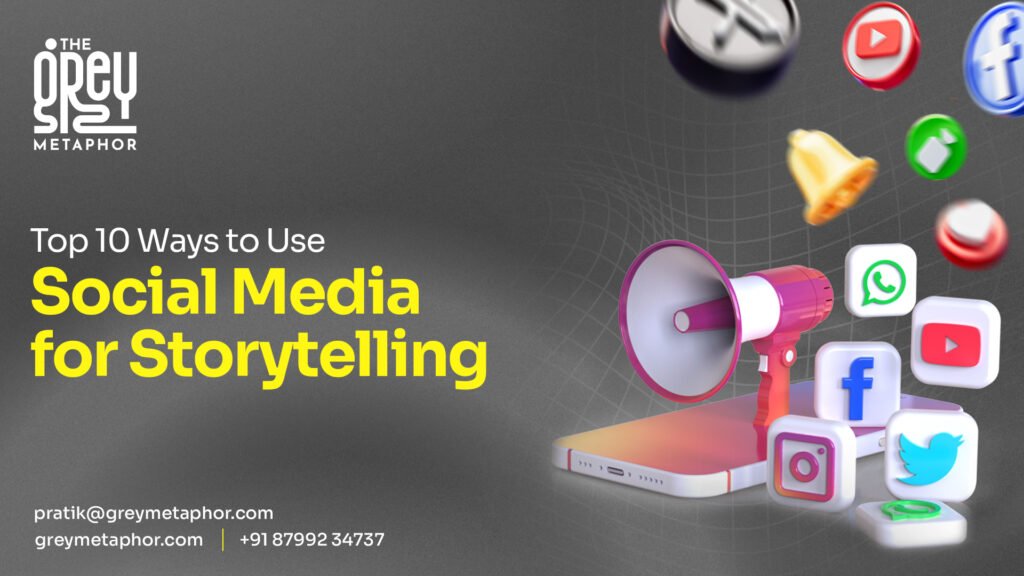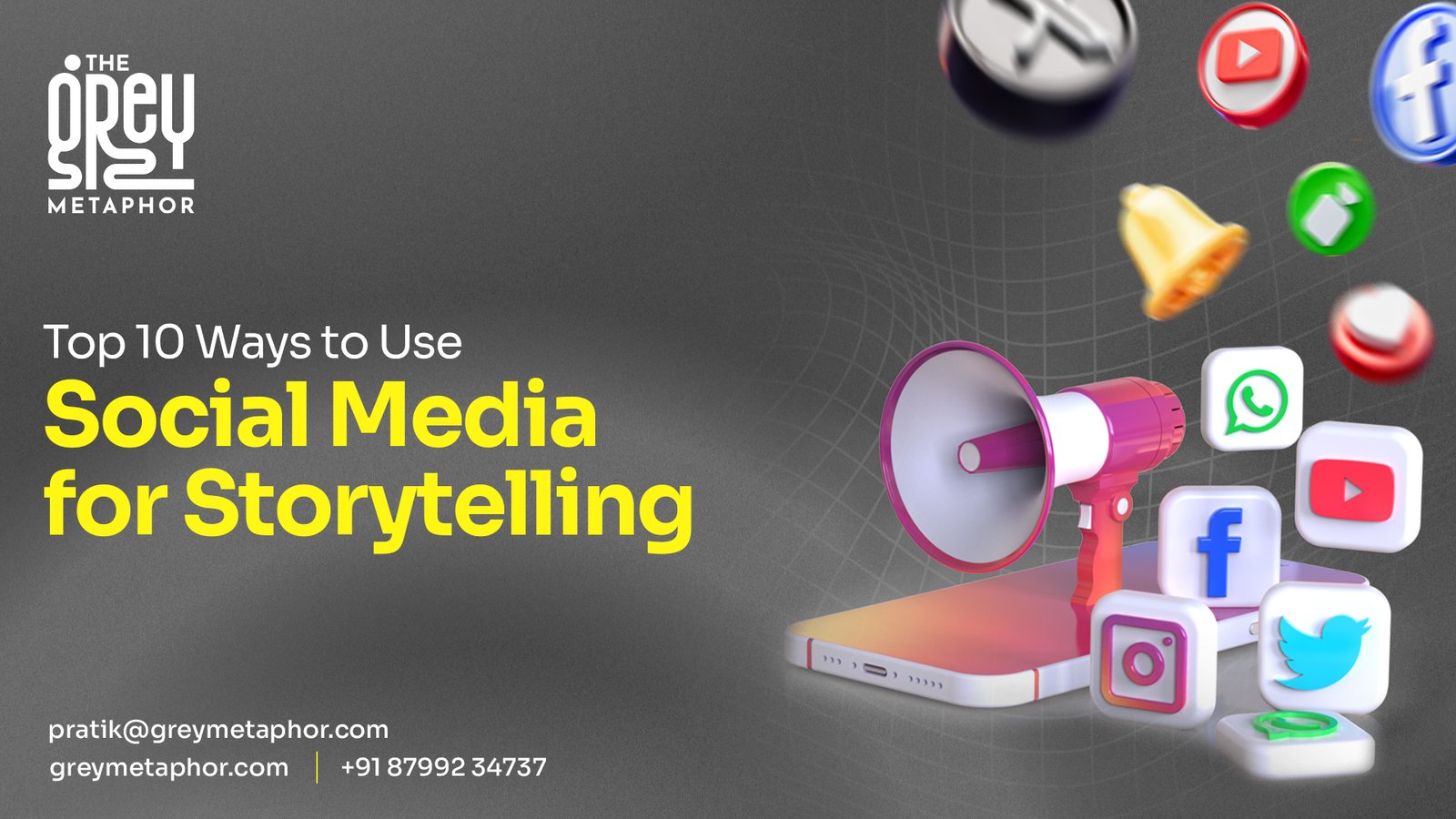In 2025, social media storytelling isn’t just marketing—it’s connection. Consumers crave raw authenticity, emotional resonance, and immersive experiences across every platform. With AI tools, short-form video, AR/VR, and shoppable features now mainstream, storytelling has become the essential art form to humanize your brand and forge deeper bonds.
Inside this guide, you’ll discover not only the Top 10 Ways to Use Social Media for Storytelling in 2025, but also:
- Real-world examples and case studies
- Step-by-step execution tips tailored to each strategy
- Insights on emerging trends and platform-specific nuances
- SEO, AEO, and VSO-optimized structure for discoverability and voice search

Let’s dive in and transform your narrative presence in the post-digital era.
1. Hook with Short‑Form Video Narrative
Why It Works in 2025:
Short-form video continues to dominate user attention, with platforms like TikTok, Reels, and Shorts leading social feeds. These formats demand succinct storytelling—with emotional hooks, quick pacing, and strong visual delivery.
Case Study:
A sustainable fashion brand posted a 15-second reel showing an item transforming from raw fabric to final outfit. The video—backed by motivating music and a concise message—went viral, boosting likes by 300% and driving profile visits by 45%.
Execution Tips:
- Begin with a strong visual or provocative statement within the first 1–3 seconds
- Incorporate motion, text overlays, or narration to communicate quickly
- End with a micro call-to-action: “Save this tip” or “Watch part 2 tomorrow”
Platform Optimization:
- TikTok: Use trending audio and feature-related hashtags (#SlowFashionNarrative, #BehindTheStitch)
- Instagram Reels: Add punchy captions with brand keywords
- YouTube Shorts: Drive curiosity with open loops (“What happens next?”)
2. Leverage AI-Generated Content with a Human Core
Why It Works in 2025:
AI tools rapidly generate drafts, visuals, and creative ideas—giving brands efficiency without sacrificing narrative potential. When combined with human editing, they optimize storytelling authenticity and speed.
Example:
A wellness brand used AI to script its weekly Instagram voice-over. They added inflections of warmth and authenticity manually—resulting in record engagement and comments like, “Your brand feels like a friend.”
Execution Tips:
- Use AI to draft headlines, visuals, or dialogue outlines.
- Review manually—infuse brand tone, empathy, and nuance.
- Share AI-assisted posts but transparently (e.g., “AI helped draft this story—then we added our own touch!”).
Ethical Reminder:
Stay authentic. Over-reliance on AI can lead to bland or disingenuous content. Always put brand voice and truth first.
3. Illuminate Authenticity via User‑Generated Content (UGC)
Why It Works in 2025:
UGC builds trust and demonstrates real-life validation. When people see others using—and enjoying—your products or services, emotional credibility soars.
Example:
A gourmet coffee brand encouraged customers to share “first sip” moments. The resulting photo series (#MyMorningBrew) generated a flood of emotionally rich UGC, boosting stories with heartfelt reviews.
Execution Tips:
- Run an open-ended UGC campaign (e.g., “Tell us how our product transformed your morning.”)
- Display compelling UGC in your feed and highlight real customer stories
- Offer incentives like reposts or discounts to contributors
4. Foster Community with Interactive Formats
Why It Works in 2025:
Interactive content builds ownership and empathy—turning passive followers into engaged community members.
Example:
A skincare brand launched a weekly Instagram Live: “Behind the Routine,” inviting followers to ask product questions. The result: Repeat attendance, better retention, and over 20% of viewers converted within 24 hours.
Execution Tips:
- Schedule regular live events with consistent themes (e.g., tutorials, AMA)
- Promote participation (polls, quizzes, emoji reactions) to maintain attention
- Repost clips afterward to maintain reach
5. Master Transmedia Storytelling Across Platforms
Why It Works in 2025:
A multi-channel narrative invites people deeper, allowing them to connect at their preferred level—whether micro or macro story.
Example:
A travel influencer shared a “Day in Kyoto” story: TikTok videos highlighted local food, Reels showed temple scenes, while a blog post detailed the emotional journey. Each piece complemented the other, driving cross-platform traffic.
Execution Tips:
- Create a central pillar story (e.g., brand origin)
- Break it into platform-native fragments: Posts, videos, blogs, podcasts
- Cross-promote (“Full story on the blog—link in bio!”)
6. Integrate Social Commerce into Your Stories
Why It Works in 2025:
Story-led commerce removes friction from the buyer’s journey. By narrating the product’s benefit as part of a story, the sell feels natural and engaging.
Example:
A jewelry brand created a “Meaning behind the design” mini-video series, each making products shoppable. Engagement soared, and one collection’s sales jumped 50% within launch week.
Execution Tips:
- Use shoppable posts with engaging story context
- Build urgency through narrative (e.g., “last chance”, “crafted for your moment”)
- Add tap-to-buy overlays in Instagram Stories or TikTok Shop
7. Elevate Stories with Immersive AR/VR and Cinematic Content
Why It Works in 2025:
AR filters and cinematic storytelling make narratives experiential—turning audiences from viewers into participants.
Example:
A beauty brand released an AR filter that visualized custom foundation shades. Users posted their “skin matches,” expanding reach and engagement organically.
Execution Tips:
- Use AR filters for product demo or interactive storytelling
- Produce cinematic-style short videos: moody lighting, narrative soundtracks, fine details
- Embed 360° content on platforms that support it (Facebook, YouTube)
8. Use Voice, Audio, and Podcasts for Personal Connection
Why It Works in 2025:
Audio experiences foster intimacy and introspection—ideal for emotionally rich storytelling.
Example:
A family-owned bakery posted 60-second voice vignettes: reading letters from founders or describing recipe origins. Engagement and emotional comments skyrocketed.
Execution Tips:
- Develop short-form audio snippets for Stories
- Launch micro-podcast episodes centered around user stories or brand values
- Use live audio rooms (Twitter/X Spaces) for real-time brand storytelling
9. Craft Zero‑Click Stories with Value‑First Micro Content
Why It Works in 2025:
Zero-click content delivers immediate payoff—short bursts of inspiration, tips, or emotion—that don’t require navigation away from the platform.
Example:
A wellness coach shared single-image infographics with a powerful quote and a one-line insight. Saves and re-shares went through the roof, with direct messages praising the clarity and impact.
Execution Tips:
- Use bold visuals or text overlays for clarity
- Frame a mini-story or lesson in a snapshot («How a morning mindset changed everything»)
- Add a CTA like “Tap Save to return later”
10. Launch Episodic/Serialized Storytelling (Social Sitcoms)
Why It Works in 2025:
Serialization builds emotional investment. Characters or themes that reappear encourage loyalty and habitual views.
Example:
A pet wellness brand created a weekly “Pet Adventures” series—every episode featuring a new furry friend and wellness tip. Audiences began following episodes like they would a TV show.
Execution Tips:
- Build recurring characters or team personas
- Pre-plan content arcs (introduce conflict, evolve, resolve)
- Tease upcoming episodes and harness cliffhangers (“Next week: Surprise guest!”)
Conclusion
In 2025, the art of social media storytelling lies in blending authenticity with innovation. To resonate:
- Combine AI, short-form video, and UGC to humanize your story
- Build community via interactivity and transmedia narratives
- Connect across senses using commerce-led narratives, AR, audio, and serialization
- Make storytelling inclusive—regardless of platform or format
By embracing these strategies, you’ll not just tell stories—you’ll co-create memorable experiences with your audience.



Leave a Reply